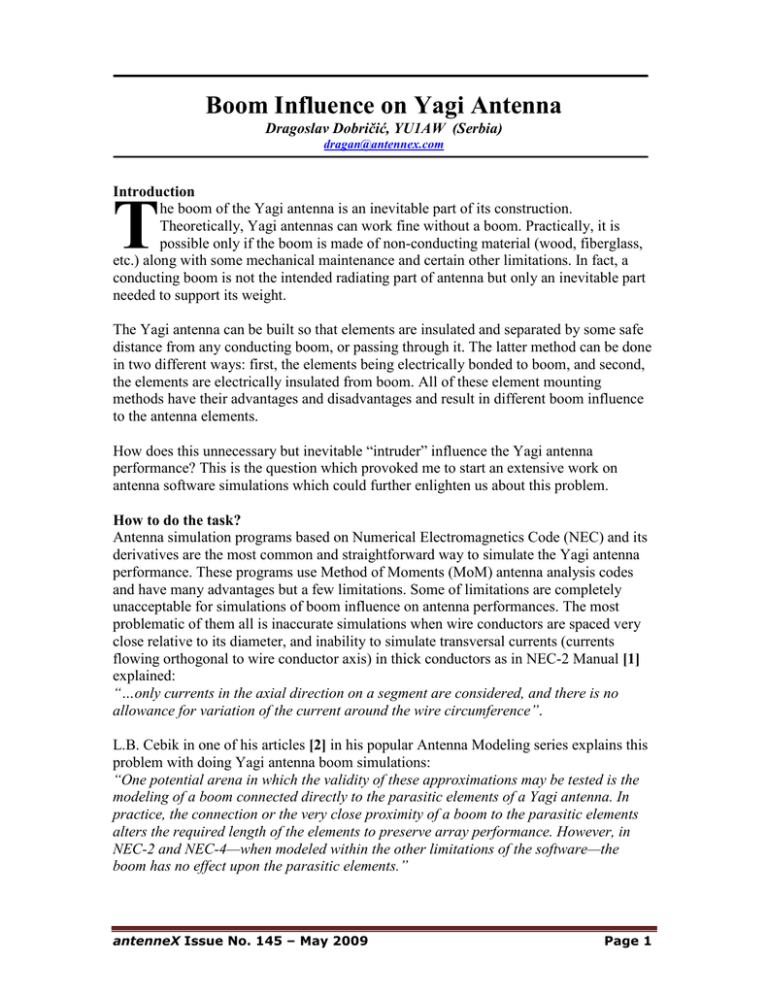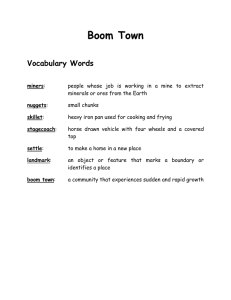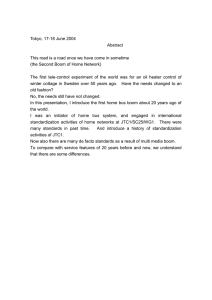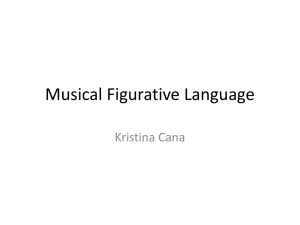
Boom Influence on Yagi Antenna
Dragoslav Dobričić, YU1AW (Serbia)
dragan@antennex.com
Introduction
he boom of the Yagi antenna is an inevitable part of its construction.
Theoretically, Yagi antennas can work fine without a boom. Practically, it is
possible only if the boom is made of non-conducting material (wood, fiberglass,
etc.) along with some mechanical maintenance and certain other limitations. In fact, a
conducting boom is not the intended radiating part of antenna but only an inevitable part
needed to support its weight.
T
The Yagi antenna can be built so that elements are insulated and separated by some safe
distance from any conducting boom, or passing through it. The latter method can be done
in two different ways: first, the elements being electrically bonded to boom, and second,
the elements are electrically insulated from boom. All of these element mounting
methods have their advantages and disadvantages and result in different boom influence
to the antenna elements.
How does this unnecessary but inevitable “intruder” influence the Yagi antenna
performance? This is the question which provoked me to start an extensive work on
antenna software simulations which could further enlighten us about this problem.
How to do the task?
Antenna simulation programs based on Numerical Electromagnetics Code (NEC) and its
derivatives are the most common and straightforward way to simulate the Yagi antenna
performance. These programs use Method of Moments (MoM) antenna analysis codes
and have many advantages but a few limitations. Some of limitations are completely
unacceptable for simulations of boom influence on antenna performances. The most
problematic of them all is inaccurate simulations when wire conductors are spaced very
close relative to its diameter, and inability to simulate transversal currents (currents
flowing orthogonal to wire conductor axis) in thick conductors as in NEC-2 Manual [1]
explained:
“…only currents in the axial direction on a segment are considered, and there is no
allowance for variation of the current around the wire circumference”.
L.B. Cebik in one of his articles [2] in his popular Antenna Modeling series explains this
problem with doing Yagi antenna boom simulations:
“One potential arena in which the validity of these approximations may be tested is the
modeling of a boom connected directly to the parasitic elements of a Yagi antenna. In
practice, the connection or the very close proximity of a boom to the parasitic elements
alters the required length of the elements to preserve array performance. However, in
NEC-2 and NEC-4—when modeled within the other limitations of the software—the
boom has no effect upon the parasitic elements.”
antenneX Issue No. 145 – May 2009
Page 1
Some good illustration of the NEC program’s inability to simulate even the presence of
boom is given on the figures to follow. From antenna simulation results we see there are
no differences between results for antennas with and without a boom. Radiation patterns
of antennas with and without boom completely overlay each other.
Thus, a boom set in the antenna axis is completely “invisible” for NEC (MoM) based
programs. Nothing changes if elements which are passing through the boom are
electrically bonded or insulated from the boom. Also, whether boom is placed close to the
antenna axis, little above or little under the elements, as in antennas with insulated
elements, has no influence on diagram simulation results. With this in mind I decided to
use programs which are based on different methods for solving electromagnetic
properties of an antenna.
Programs based on Finite Difference Time Domain methods (FDTD) or Finite
Integration Technique method (FIT), which use spatial discretization scheme for solving
various electromagnetic problems, give much better opportunity for successful and more
accurate simulations and answers to many questions.
Unfortunately, these professional programs are more time consuming, need a much more
powerful computer, along with adequate user skill and knowledge than MoM-based
programs. This is one of the main reasons, beside availability and high price, which
prevent them from being used more in amateur radio antenna designs.
Simulations of a few Yagi antennas with and without a conducting boom with such
advanced programs show clear difference and all of the boom effects on Yagi antenna
performance, as can be seen in the comparative figures below.
H-plane diagram of Yagi antenna with different boom radius (br) and with no boom,
simulated in MoM (left) and FIT (right) software
antenneX Issue No. 145 – May 2009
Page 2
E-plane diagram of Yagi antenna with different boom radius (br) and with no boom,
simulated in MoM (left) and FIT (right) software
Input resistance of Yagi antenna with different boom radius (br) and with no boom,
simulated in MoM (left) and FIT (right) software
Input reactance of Yagi antenna with different boom radius (br) and with no boom,
simulated in MoM (left) and FIT (right) software
antenneX Issue No. 145 – May 2009
Page 3
Input return loss of Yagi antenna with different boom radius (br) and with no boom,
simulated in MoM (left) and FIT (right) software
Broadband directivity of Yagi antenna with different boom radius (br) and with no
boom, simulated in MoM (left) and FIT (right) software
Results comparison
Yagi antennas for 144 MHz were simulated without boom and later with a conductive
round tube boom added. The boom is placed below the elements so that distance between
the boom’s top-most surface and elements axis is kept at a constant value of 7 mm. Then
boom radius (br) was changed from 10 to 50 mm. It represented a simulation of a Yagi
antenna with elements insulated from a boom and mounted on booms with different
diameters (20-100 mm) with the aid of plastic insulators with very low dielectric
permittivity and constant height of elements above the boom.
On the figures on the left side there are results of simulations of MoM based program
which show no difference and all curves completely overlapping each other. On the right
side there are results of FIT based program. We can see different curves for antenna with
no boom and for antenna with different boom radius. It is obvious that the presence of a
conductive boom and its diameter value has an influence on a Yagi antenna and changes
both of the antenna radiation pattern and input impedance. From the theoretical
calculations and practical measurements it is known that the presence of a thick
conductive boom near the elements tends to shorten effective length of the elements and
thus shifts performance of the antenna to a higher frequency.
antenneX Issue No. 145 – May 2009
Page 4
On the diagrams presented we can see that curves of both input resistance and reactance
shift on higher frequency simultaneously with enlargement of the boom diameter. As a
result of this, antenna resonance and curves of antenna input return loss also shift to a
higher frequency. As expected, broadband directivity curves also shift toward higher
frequencies. Interestingly, boom influences on antenna produce frequency shifts which
are just opposite of those that the moist on antenna elements does.
Boom correction
In the case of the performance frequency shift it is necessary to compensate for the length
of elements to maintain antenna performances on the desired intended frequency.
Mounting method, boom and elements diameter and distance between boom and
elements determine magnitude of a boom’s impact and value of the necessary elements
length correction.
Length correction for elements mounted above the boom is proportional to the boom and
the element diameters and distance between elements and boom. A general rule of thumb
is that for 144 MHz band elements mounted just above the boom surface but electrically
insulated from the boom, the correction is about 25% of the boom diameter. For elements
that are mounted higher above boom surface, elements length correction decreases. And
at about half of the boom diameter height correction is not necessary because of
negligible influence of the boom to the elements’ effective length.
For elements passing through the boom and electrically bonded to it, a correction is about
25-45% depending on boom diameter. For elements passing through the boom but
insulated from it, a correction is 15-25 % of boom diameter—for usual boom diameters
(20-50 mm). Higher correction percentage is for booms with larger diameter which show
a more severe boom influence on the antenna.
On higher frequencies, the correction percentage is higher. At 432 MHz it is about two
times higher than on 144 MHz.
Average Q-factor of dry and wet (0.1 mm) Yagi antennas of various experimenters
antenneX Issue No. 145 – May 2009
Page 5
Boom length and average gain of dry and wet (0.1 mm) Yagi antennas of various
experimenters
Boom effects vs. antenna design
Different Yagi antenna designs show different sensitivity to environmental impacts and I
expected that an antenna boom, as an intruder, can show different effects on different
antenna designs as well.
In order to conduct as fair comparisons as possible, I decided to use 6 different Yagi
antennas which have the same boom length, very similar gain but different sensitivity to
environmental impacts due to their different Q factors. These 6 antennas (marked with
light blue color) are given on figures which show their boom length, gain and Q factors
when they are dry and are wet [3]. As can be seen, they all have the same boom length of
4 wavelengths, gain of around 16 dBi, but when dry or wet, the antenna Q factors differ
by more than 10 times! On the same boom length, these six antennas have different
number of elements, between 12 and 16.
One of antennas (DL6WU-15) has three different versions (depending on the particular
program used for its dimension calculation) but all give very similar results. In this
analysis the version of antenna calculated by the G3SEK program and marked as
DL6WU 15* will be simulated and used for comparison.
All six antennas will be simulated keeping all the other conditions the same and with
highest reasonable accuracy which is acceptable according to computer power and time
consumption.
antenneX Issue No. 145 – May 2009
Page 6
Just as an illustration of this huge work: very fast and powerful computer with a very
high amount of RAM took hundreds and hundreds of hours of CPU time, mainly during
nights and weekends for five months until now! And it is not finished yet, because at this
very moment, the results of just part of the overall task have come out, and many new
questions and ideas arise.
In the next few antenneX issues I will present various simulation results of these 6 Yagi
antennas and make some comparisons. Beside the different boom diameter influences,
different distance between elements and boom will be investigated. Also some accidental
errors in the elements’ symmetrical mounting on the boom and square and round crosssection booms will be simulated and compared. Finally, different elements mounting and
its length corrections will be simulated and compared. -30References:
1. NEC-2 Manual, Part III: User’s Guide, Section II – Structure Modeling Guidelines,
Wire Modeling, pages 7-9.
http://wireless.ictp.it/school_2005/download/nec2/
2. L. B. Cebik, W4RNL, When Not to Use NEC for Antenna Modeling,
http://guests.antennex.com/rooms/w4rnl/col1008/amod128.htm
1. 3. Dragoslav Dobričić, YU1AW, Yagi Antenna Design Sensitivity in Practice,
antenneX, November 2008, Issue No. 139.
BRIEF BIOGRAPHY OF THE AUTHOR
Dragoslav Dobričić, YU1AW, is a retired electronic
Engineer and worked for 40 years in Radio Television
Belgrade on installing, maintaining and servicing radio and
television transmitters, microwave links, TV and FM repeaters
and antennas. At the end of his career, he mostly worked on
various projects for power amplifiers, RF filters and
multiplexers, communications systems and VHF and UHF
antennas.
For over 40 years, Dragan has published articles with different
original constructions of power amplifiers, low noise
preamplifiers, antennas for HF, VHF, UHF and SHF bands.
He has been a licensed Ham radio since 1964. He is married
with two grown up children, a son and a daughter.
antenneX Online Issue No. 145 — May 2009
Send mail to webmaster@antennex.com with questions or comments.
Copyright © 1988-2009 All rights reserved - antenneX©
antenneX Issue No. 145 – May 2009
Page 7





